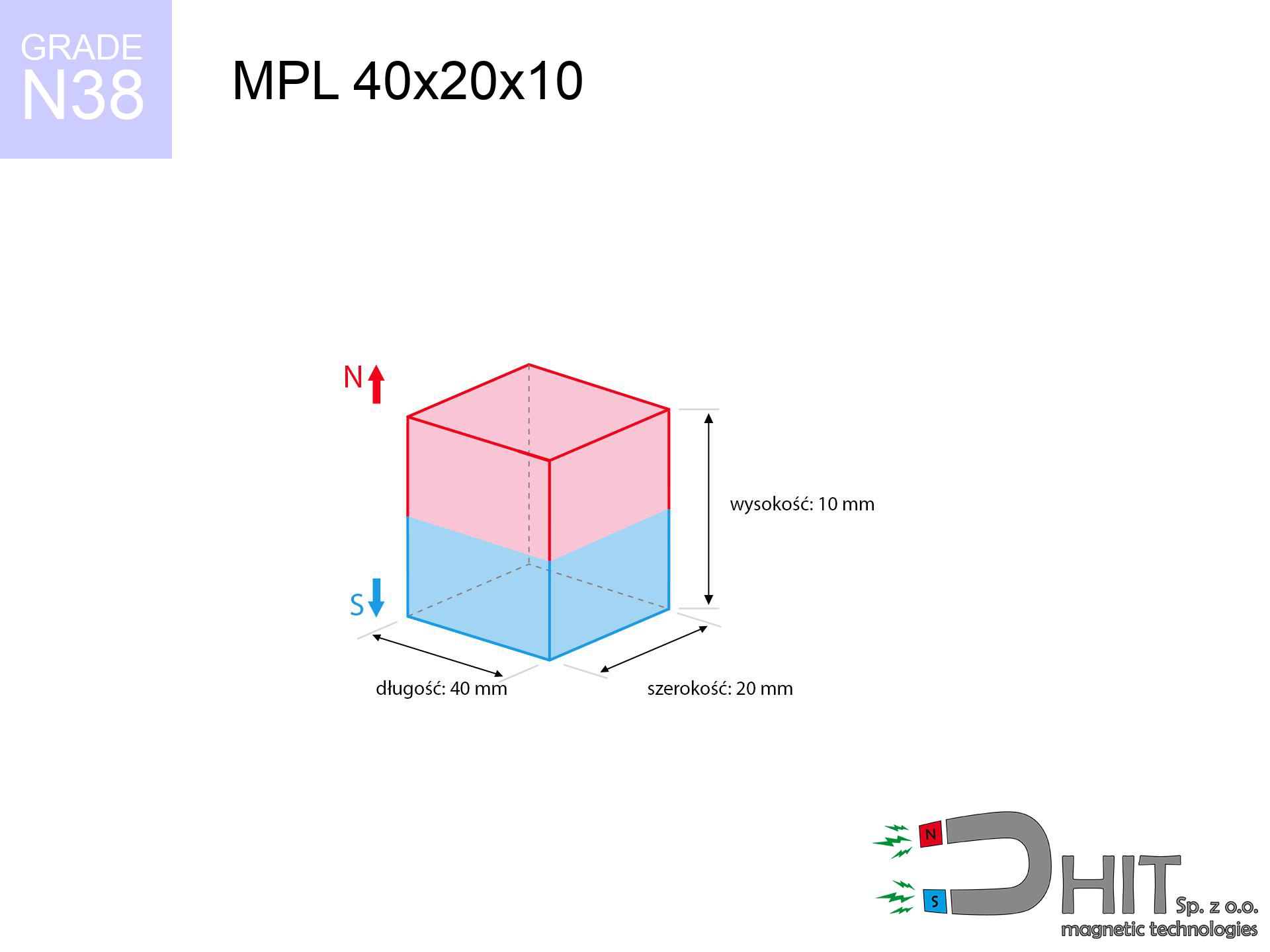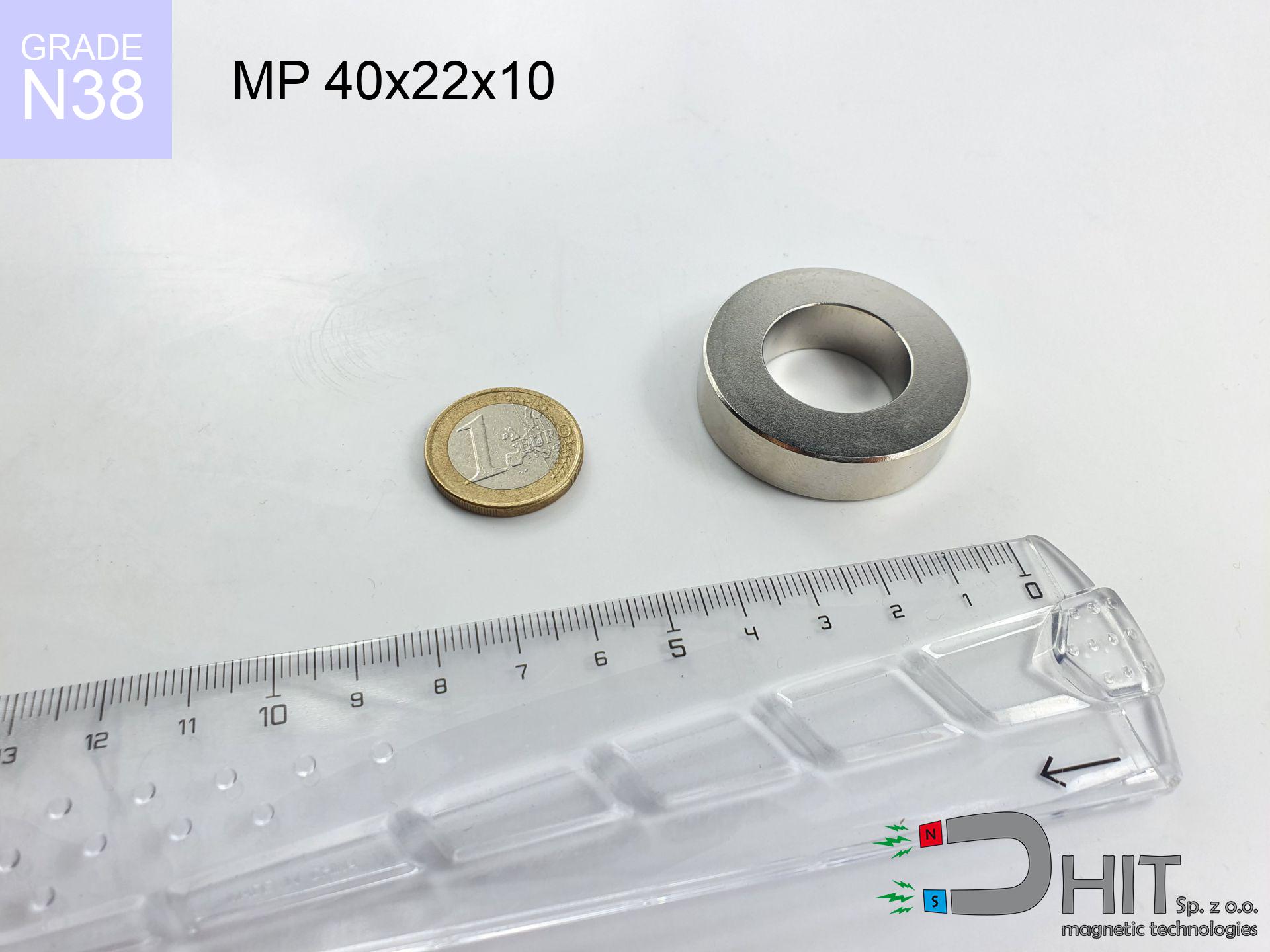MPL 40x20x10 / N38 - lamellar magnet
lamellar magnet
Catalog no 020158
GTIN: 5906301811640
length [±0,1 mm]
40 mm
Width [±0,1 mm]
20 mm
Height [±0,1 mm]
10 mm
Weight
60 g
Magnetization Direction
↑ axial
Load capacity
22.34 kg / 219.08 N
Magnetic Induction
349.60 mT
Coating
[NiCuNi] nickel
25.20 ZŁ net + 23% VAT / pcs
bulk discounts:
Need more?Want to negotiate the price?
Call us +48 22 499 98 98 or write via form on the contact page. Test the magnet's power with our power calculator.
Orders placed by 14:00 are shipped the same day.
MPL 40x20x10 / N38 - lamellar magnet
Magnetic properties of material N38
Physical properties of NdFeB
Shopping tips
Thanks to their high strength, flat magnets are frequently applied in products that need strong holding power.
Typical temperature resistance of these magnets is 80 °C, but depending on the dimensions, this value grows.
Moreover, flat magnets commonly have different coatings applied to their surfaces, such as nickel, gold, or chrome, for enhancing their strength.
The magnet labeled MPL 40x20x10 / N38 and a magnetic force ${capacity} kg weighing only ${weight} grams, making it the ideal choice for projects needing a flat magnet.
Contact surface: Thanks to their flat shape, flat magnets ensure a larger contact surface with other components, which can be beneficial in applications needing a stronger magnetic connection.
Technology applications: These magnets are often used in various devices, e.g. sensors, stepper motors, or speakers, where the thin and wide shape is necessary for their operation.
Mounting: The flat form's flat shape makes mounting, especially when it is necessary to attach the magnet to another surface.
Design flexibility: The flat shape of the magnets permits designers greater flexibility in placing them in devices, which is more difficult with magnets of other shapes.
Stability: In certain applications, the flat base of the flat magnet can offer better stability, reducing the risk of shifting or rotating. It’s important to keep in mind that the optimal shape of the magnet depends on the specific project and requirements. In certain cases, other shapes, such as cylindrical or spherical, are a better choice.
Magnets have two poles: north (N) and south (S), which attract each other when they are different. Poles of the same kind, such as two north poles, repel each other.
Thanks to this principle of operation, magnets are often used in electrical devices, such as motors, speakers, sensors, or magnetic locks. Neodymium magnets stand out with the highest power of attraction, making them perfect for applications requiring powerful magnetic fields. Moreover, the strength of a magnet depends on its dimensions and the material it is made of.
It should be noted that high temperatures can weaken the magnet's effect. Every magnetic material has its Curie point, meaning that once this temperature is exceeded, the magnet stops being magnetic. Additionally, strong magnets can interfere with the operation of devices, such as compasses, credit cards or electronic devices sensitive to magnetic fields. Therefore, it is important to exercise caution when using magnets.
Advantages and disadvantages of neodymium magnets
Neodymium magnets, also known as NdFeB magnets, are currently the strongest permanent magnets available on the market. Their exceptional magnetic properties make them suitable for various industries, technologies, and everyday life. Below are the key advantages:
- Immense attractive force: Even small neodymium magnets generate a very strong magnetic field.
- High coercivity: They are resistant to demagnetization by external magnetic fields.
- Wide operating temperature range: Standard neodymium magnets operate up to 80°C, with special versions up to 230°C.
- Variety of shapes and sizes: Available in many forms, making them easy to adapt to specific applications.
- Relatively low price compared to strength: They offer the best strength-to-price ratio among all magnets.
- Longevity: With proper use, they retain their magnetic properties for many years.
- Versatility of applications: From electric motors to speakers, separators, toys, and jewelry.
Despite numerous advantages, neodymium magnets also have certain disadvantages to consider:
- Brittleness: They are hard but brittle and prone to cracking or chipping upon impact.
- Limited operating temperature for standard versions: Above the Curie temperature, they lose their magnetic properties.
- Strong magnetic field can be dangerous: They can damage electronics, magnetic cards, and pose a risk of attracting metal objects with great force.
- Difficulties in mechanical processing: Due to their hardness and brittleness, processing them is complex.
Precautions
Do not give neodymium magnets to children.
Not all neodymium magnets are toys, so do not let children play with them. In the case of small magnets, they can be swallowed and cause choking. In such cases, the only solution is to undergo surgery to remove the magnets, and otherwise, it can even lead to death.
Neodymium magnets can attract to each other, pinch the skin, and cause significant injuries.
Magnets will attract each other within a distance of several to around 10 cm from each other. Don't put your fingers in the path of magnet attraction, as a major injury may occur. Magnets, depending on their size, are able even cut off a finger or there can be a serious pressure or a fracture.
Keep neodymium magnets away from TV, wallet, and computer HDD.
Magnetic fields generated by neodymium magnets can damage magnetic storage media such as floppy disks, credit cards, magnetic ID cards, cassette tapes, video tapes, or other similar devices. In addition, they can damage televisions, VCRs, computer monitors, and CRT displays. You should especially avoid placing neodymium magnets near electronic devices.
Neodymium magnets can become demagnetized at high temperatures.
In certain circumstances, Neodymium magnets can lose their magnetism when subjected to high temperatures.
Keep neodymium magnets as far away as possible from GPS and smartphones.
Strong fields generated by neodymium magnets interfere with compasses and magnetometers used in navigation, as well as internal compasses of smartphones and GPS devices.
Neodymium magnets are the strongest magnets ever invented. Their strength can surprise you.
To handle magnets properly, it is best to familiarize yourself with our information beforehand. This will help you avoid significant harm to your body and the magnets themselves.
Neodymium magnets are not recommended for people with pacemakers.
Neodymium magnets produce strong magnetic fields that can interfere with the operation of a heart pacemaker. Even if the magnetic field does not affect the device, it can damage its components or deactivate the entire device.
Dust and powder from neodymium magnets are flammable.
Do not attempt to drill into neodymium magnets. Mechanical processing is also not recommended. Once crushed into fine powder or dust, this material becomes highly flammable.
The magnet coating is made of nickel, so be cautious if you have an allergy.
Studies show a small percentage of people have allergies to certain metals, including nickel. An allergic reaction often manifests as skin redness and rash. If you have a nickel allergy, you can try wearing gloves or simply avoid direct contact with nickel-plated neodymium magnets.
Neodymium magnetic are noted for being fragile, which can cause them to shatter.
In the event of a collision between two neodymium magnets, it can result in them getting chipped. They are coated with a shiny nickel plating similar to steel, but they are not as hard. At the moment of connection between the magnets, small sharp metal pieces can be propelled in various directions at high speed. Eye protection is recommended.
In order to show why neodymium magnets are so dangerous, read the article - How dangerous are very strong neodymium magnets?.





![BM 750x180x70 [4x M8] - magnetic beam BM 750x180x70 [4x M8] - magnetic beam](https://cdn3.dhit.pl/graphics/products/bm-750x180x70-4x-m8-zif.jpg)


